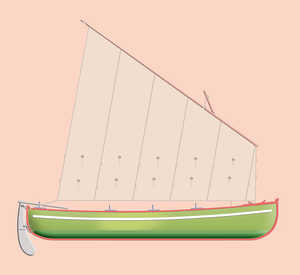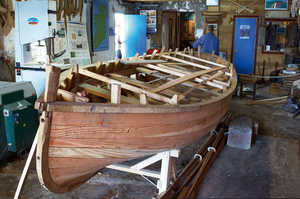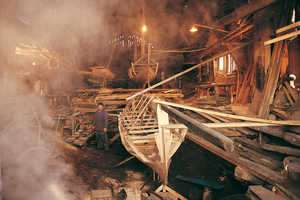The batel, the last survivor
The batel was the smallest of the fishing vessels operating on
the Basque coast.
With three or four thwarts it was used for a great number of
different tasks.
It was the fisherman's personal vessel, allowing him to go on
fishing close to the harbour when for any reason the launches
did not put out to sea. Generally these vessels had only one mast though in some
cases, they imitated the larger twin-masted launches.
During the first part of the twentieth century they were
adopted as a recreational vessel in tourist locations along
the coast. Half-way through the century, the use of sail was
finally abandoned and the shape began to be adapted for
rowing.
Recent years have seen increased interest in this vessel;
several of the traditional bateles still operating have been
restored to work under sail.

Lugrigged batel. © José Lopez

Replica of a nineteenth century batel under construction at
the Ontziola Centre for Research and Construction of Traditional
Vessels in Pasaia. The vessel is being built as part of a programme
to recover typical Basque vessels. © José Lopez

The Mutiozabal collection contains various plans of bateles
from the late eighteenth century to the early twentieth century.
Thanks to their work we now have a clear idea of its characteristics
and the developments it has experienced over that period. © José Lopez

Gozategi workshop in Orio. Jose Manuel heating up the
strakes with steam from the boiler, for the last batel built by the
coastal carpenters. It was made for the Territorial Government of
Gipuzkoa's Untzi Museoa (Shipping Museum), based on templates
for an old vessel from Orio. © José Lopez

Several traditional wooden bateles have been preserved
thanks to the efforts of a number of enthusiasts of the seafaring
tradition. They are currently used for sports fishing and recreation. © José Lopez
The interest aroused by this small vessel extends beyond the
Basque Country; in 2008, the Breton association Défi du Traict
built the first replica of a nineteenth-century Basque batel, which
they named Pasaia.
© José Lopez

Batels were used for ferrying passengers across estuaries.
Passing through Pasaia, Victor Hugo, noted that the people operating
the ferries were all women; since the port at the time was
largely given over to foreign trade, most of the menfolk were away
on board ship. © José Lopez











